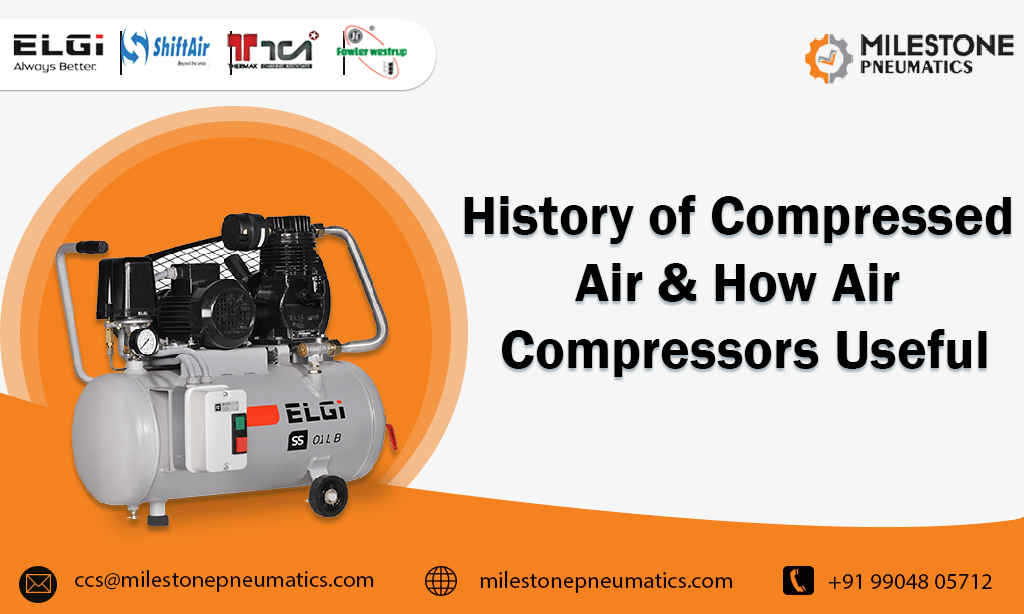Air compressors are used in a variety of industries to provide compressed and pressurized air for many applications. These devices are now even used to power construction and manufacturing equipment and to drive control system valves; earlier compressors were much less versatile. The advent of air compressors dates back thousands of years.
The history of air compressor use can be traced back thousands of years to when early civilizations discovered the power of the human lung. With its ability to exhale oxygen, the lung made it easier to build fires for cooking and keeping warm. Since the human body can exhale oxygen, people once used their breath to stoke fires.
Healthy lungs can only produce 0.02 to 0.08 bar (1 bar equates to 14.5 psi) of air pressure—hardly adequate for metalworking tasks. Also, the carbon dioxide content in human breath wasn’t helpful for sustaining fires. The demand for stronger air compressors began to grow as time progressed.
Sometime around 3000 B.C., developments were made in the branch of science known as metallurgy, which concerns the study of metal production. Among metalsmiths, it became apparent that hotter forms of air were needed to turn liquidized minerals like copper and gold into hard metals.
BELLOWS
The earliest man-made air device was the blowpipe, which metallurgists in Egypt used in the production of precious metals seen in ancient tombs. This was followed by manually operated bellows — the world’s first mechanical compressed air device. Consisting of a flexible bag, the device made compressed-air production a whole lot easier. The accordion-like device sucks air in through one side while extended, and then pushes the air out through the other end when the handles are squeezed together.
Around 1500 B.C., the introduction of foot-operated bellows — safer to operate and without the strain factor to the arms and hands — allowed for a more practical way of producing air for metalworking. Bellows remained the standard in compressed air production for the next two millenniums. Even though bellows bear little resemblance to the modern-day air compressor, they were capable of sustaining fires with enough heat to meld iron ores. Today, bellows are still used in certain applications, including breathing devices used in hospitals.
VACUUM PUMPS & BLASTING UNITS:
The development of blast furnaces brought about the need for a more powerful form of compressed air. In 1650, German physicist Otto von Guericke designed a vacuum pump that could pull gas through tiny chambers and leave compartments air-free.
More than a century later, John Smeaton conceived an even more influential idea. He was the world’s first professional engineer, and in 1762, he designed a new type of blowing device driven by water wheels. This was followed in 1776 by English inventor John Wilkinson, who created a high-powered blasting unit
SCIENCE ADVANCING
With science advancing, new air compressors were invented to expand the uses for compression. In 1650, German scientist Otto von Guericke devised a single piston and cylinder air pump. In 1797, the first motorized compressor was designed by George Medhurst of England. By the 18th century, scientist discovered that compressed air could be used as a source of energy to power and move items. The discovery happened when water boiling in a container exploded and moved an item. After this discovery, compressed air was used for rock drilling. In the 19th century, Paris devised an air compressor grid system to power their clocks with a pulse of air every minute. Paris, also in the 19th century, experimented with the idea of air compressor systems as an alternative to electricity.
INDUSTRIAL AGE
With the birth of the industrial age, air compression gained new uses in the field of manufacturing. The 20th century saw the use of piston compression air compressors in the industry. In 1930, the screw compressor, first invented in 1878 Germany, offered quieter forms of air compression. By the end of the 20th century, there were three main types of compressors used. The reciprocating, or, Piston Compressors was used for oil refineries, gas pipelines, and refrigeration plants. They draw air in through an intake valve then out through an outlet. Its pistons are driven by a crankshaft to deliver air at high pressures. The rotary compressors, a type of gas compressor, emerged after the piston compressor. They deliver larger volumes of high-pressure air which is good for industrial use. These compressors use a continuous sweeping motion to limit pulsation. And, the jet compressor uses pressurized water or gas to force air out a cylinder or diffuser.
Today, compressors are used in all walks of life. They are found on construction sites, factories, medical offices and homes. The history of air compressors will continue to evolve as technological advances create different demands for compressed air and the quality of compressors improves.
If you need help please contact us at 079-29683107 / +91 99048 05712. or visit https://milestonepneumatics.com/





